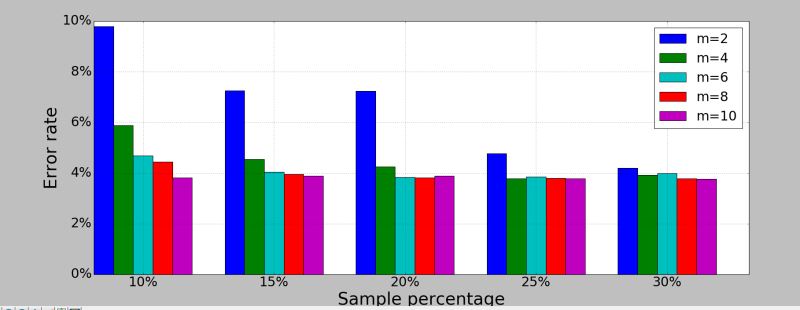Python画图主要用到matplotlib这个库。Matplotlib 是一个 Python 的 2D绘图库,它以各种硬拷贝格式和跨平台的交互式环境生成出版质量级别的图形。
具体来说是pylab和pyplot这两个子库。这两个库可以满足基本的画图需求,而条形图,散点图等特殊图,下面再单独具体介绍。
首先给出pylab神器镇文:pylab.rcParams.update(params)。这个函数几乎可以调节图的一切属性,包括但不限于:坐标范围,axes标签字号大小,xtick,ytick标签字号,图线宽,legend字号等。
具体参数参看官方文档:http://matplotlib.org/users/customizing.html
首先给出一个Python3画图的例子。
|
1
2
3
4
5
6
7
8
9
10
11
12
13
14
15
16
17
18
19
20
21
22
23
24
25
26
27
28
29
30
31
32
33
34
35
36
37
38
39
40
41
42
43
|
import matplotlib.pyplot as pltimport matplotlib.pylab as pylabimport scipy.ioimport numpy as npparams={ 'axes.labelsize': '35', 'xtick.labelsize':'27', 'ytick.labelsize':'27', 'lines.linewidth':2 , 'legend.fontsize': '27', 'figure.figsize' : '12, 9' # set figure size}pylab.rcParams.update(params) #set figure parameter#line_styles=['ro-','b^-','gs-','ro--','b^--','gs--'] #set line style #We give the coordinate date directly to give an example.x1 = [-20,-15,-10,-5,0,0,5,10,15,20]y1 = [0,0.04,0.1,0.21,0.39,0.74,0.78,0.80,0.82,0.85]y2 = [0,0.014,0.03,0.16,0.37,0.78,0.81,0.83,0.86,0.92]y3 = [0,0.001,0.02,0.14,0.34,0.77,0.82,0.85,0.90,0.96]y4 = [0,0,0.02,0.12,0.32,0.77,0.83,0.87,0.93,0.98]y5 = [0,0,0.02,0.11,0.32,0.77,0.82,0.90,0.95,1] plt.plot(x1,y1,'bo-',label='m=2, p=10%',markersize=20) # in 'bo-', b is blue, o is O marker, - is solid line and so onplt.plot(x1,y2,'gv-',label='m=4, p=10%',markersize=20)plt.plot(x1,y3,'ys-',label='m=6, p=10%',markersize=20)plt.plot(x1,y4,'ch-',label='m=8, p=10%',markersize=20)plt.plot(x1,y5,'mD-',label='m=10, p=10%',markersize=20) fig1 = plt.figure(1)axes = plt.subplot(111) #axes = plt.gca()axes.set_yticks([0.1,0.2,0.3,0.4,0.5,0.6,0.7,0.8,0.9,1.0])axes.grid(True) # add grid plt.legend(loc="lower right") #set legend locationplt.ylabel('Percentage') # set ystick labelplt.xlabel('Difference') # set xstck label plt.savefig('D:\\commonNeighbors_CDF_snapshots.eps',dpi = 1000,bbox_inches='tight')plt.show() |
显示效果如下:

代码没什么好说的,这里只说一下plt.subplot(111)这个函数。
plt.subplot(111)和plt.subplot(1,1,1)是等价的。意思是将区域分成1行1列,当前画的是第一个图(排序由行至列)。
plt.subplot(211)意思就是将区域分成2行1列,当前画的是第一个图(第一行,第一列)。以此类推,只要不超过10,逗号就可省去。
python画条形图。代码如下。
|
1
2
3
4
5
6
7
8
9
10
11
12
13
14
15
16
17
18
19
20
21
22
23
24
25
26
27
28
29
30
31
32
33
34
35
36
37
38
39
40
41
42
43
44
|
import scipy.ioimport numpy as npimport matplotlib.pylab as pylabimport matplotlib.pyplot as pltimport matplotlib.ticker as mtickparams={ 'axes.labelsize': '35', 'xtick.labelsize':'27', 'ytick.labelsize':'27', 'lines.linewidth':2 , 'legend.fontsize': '27', 'figure.figsize' : '24, 9'}pylab.rcParams.update(params)y1 = [9.79,7.25,7.24,4.78,4.20]y2 = [5.88,4.55,4.25,3.78,3.92]y3 = [4.69,4.04,3.84,3.85,4.0]y4 = [4.45,3.96,3.82,3.80,3.79]y5 = [3.82,3.89,3.89,3.78,3.77]ind = np.arange(5) # the x locations for the groupswidth = 0.15plt.bar(ind,y1,width,color = 'blue',label = 'm=2') plt.bar(ind+width,y2,width,color = 'g',label = 'm=4') # ind+width adjusts the left start location of the bar.plt.bar(ind+2*width,y3,width,color = 'c',label = 'm=6')plt.bar(ind+3*width,y4,width,color = 'r',label = 'm=8')plt.bar(ind+4*width,y5,width,color = 'm',label = 'm=10')plt.xticks(np.arange(5) + 2.5*width, ('10%','15%','20%','25%','30%'))plt.xlabel('Sample percentage')plt.ylabel('Error rate')fmt = '%.0f%%' # Format you want the ticks, e.g. '40%'xticks = mtick.FormatStrFormatter(fmt) # Set the formatteraxes = plt.gca() # get current axesaxes.yaxis.set_major_formatter(xticks) # set % format to ystick.axes.grid(True)plt.legend(loc="upper right")plt.savefig('D:\\errorRate.eps', format='eps',dpi = 1000,bbox_inches='tight')plt.show() |
结果如下:

画散点图,主要是scatter这个函数,其他类似。
画网络图,要用到networkx这个库,下面给出一个实例:
|
1
2
3
4
5
6
7
8
9
10
11
12
13
14
15
16
17
18
19
20
21
22
23
24
25
26
27
28
29
30
31
32
33
34
35
36
37
38
39
40
41
42
43
44
45
|
import networkx as nximport pylab as pltg = nx.Graph()g.add_edge(1,2,weight = 4)g.add_edge(1,3,weight = 7)g.add_edge(1,4,weight = 8)g.add_edge(1,5,weight = 3)g.add_edge(1,9,weight = 3) g.add_edge(1,6,weight = 6)g.add_edge(6,7,weight = 7)g.add_edge(6,8,weight = 7) g.add_edge(6,9,weight = 6)g.add_edge(9,10,weight = 7)g.add_edge(9,11,weight = 6)fixed_pos = {1:(1,1),2:(0.7,2.2),3:(0,1.8),4:(1.6,2.3),5:(2,0.8),6:(-0.6,-0.6),7:(-1.3,0.8), 8:(-1.5,-1), 9:(0.5,-1.5), 10:(1.7,-0.8), 11:(1.5,-2.3)} #set fixed layout location#pos=nx.spring_layout(g) # or you can use other layout set in the modulenx.draw_networkx_nodes(g,pos = fixed_pos,nodelist=[1,2,3,4,5],node_color = 'g',node_size = 600)nx.draw_networkx_edges(g,pos = fixed_pos,edgelist=[(1,2),(1,3),(1,4),(1,5),(1,9)],edge_color='g',width = [4.0,4.0,4.0,4.0,4.0],label = [1,2,3,4,5],node_size = 600)nx.draw_networkx_nodes(g,pos = fixed_pos,nodelist=[6,7,8],node_color = 'r',node_size = 600)nx.draw_networkx_edges(g,pos = fixed_pos,edgelist=[(6,7),(6,8),(1,6)],width = [4.0,4.0,4.0],edge_color='r',node_size = 600) nx.draw_networkx_nodes(g,pos = fixed_pos,nodelist=[9,10,11],node_color = 'b',node_size = 600)nx.draw_networkx_edges(g,pos = fixed_pos,edgelist=[(6,9),(9,10),(9,11)],width = [4.0,4.0,4.0],edge_color='b',node_size = 600)plt.text(fixed_pos[1][0],fixed_pos[1][1]+0.2, s = '1',fontsize = 40)plt.text(fixed_pos[2][0],fixed_pos[2][1]+0.2, s = '2',fontsize = 40)plt.text(fixed_pos[3][0],fixed_pos[3][1]+0.2, s = '3',fontsize = 40)plt.text(fixed_pos[4][0],fixed_pos[4][1]+0.2, s = '4',fontsize = 40)plt.text(fixed_pos[5][0],fixed_pos[5][1]+0.2, s = '5',fontsize = 40)plt.text(fixed_pos[6][0],fixed_pos[6][1]+0.2, s = '6',fontsize = 40)plt.text(fixed_pos[7][0],fixed_pos[7][1]+0.2, s = '7',fontsize = 40)plt.text(fixed_pos[8][0],fixed_pos[8][1]+0.2, s = '8',fontsize = 40)plt.text(fixed_pos[9][0],fixed_pos[9][1]+0.2, s = '9',fontsize = 40)plt.text(fixed_pos[10][0],fixed_pos[10][1]+0.2, s = '10',fontsize = 40)plt.text(fixed_pos[11][0],fixed_pos[11][1]+0.2, s = '11',fontsize = 40)plt.show() |
结果如下:

总结
以上就是本文关于Python科学画图代码分享的全部内容,希望对大家有所帮助。感兴趣的朋友可以继续参阅本站其他相关专题,如有不足之处,欢迎留言指出。感谢朋友们对本站的支持!
原文链接:https://www.cnblogs.com/zqiguoshang/p/5744563.html










